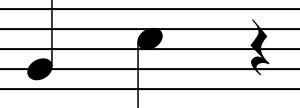Quarter note



 = 2×
= 2× ,etc.
,etc.| Drum pattern, accompanied byride patternsof various duple lengths from | |||
Aquarter note(American) orcrotchet(/ˈkrɒtʃɪt/KROTCH-it) (British) is amusical noteplayed for one quarter of the duration of awhole note(or semibreve). Quarter notes are notated with a filled-in ovalnote headand a straight, flaglessstem.The stem usually points upwards if it is below the middle line of thestaff,and downwards if it is on or above the middle line. An upward stem is placed on the right side of the notehead, a downward stem is placed on the left (see image). TheUnicodesymbol is U+2669 (♩).
Aquarterrest(orcrotchet rest) denotes a silence of the same duration as a quarter note. It typically appears as the symbol![]() ,or occasionally, as the older symbol
,or occasionally, as the older symbol![]() .[a][1]
.[a][1]
History
[edit]The note equates to thesemiminima('half minim') ofmensural notation.The word "crotchet" comes fromOld Frenchcrochet,meaning 'little hook', diminutive ofcroc,'hook', because of the hook used on the note inblack notationof the medieval period.
As the name implies, a quarter note's duration is one quarter that of a whole note, half the length of a half note, and twice that of an eighth note. It represents one beat in a bar of4
4time. The term "quarter note" is acalque(loan-translation) of the German termViertelnote.
InRomance languages,the name of this note and its equivalent rest is usually derived from theLatinnegrameaning 'black'—the Catalan, French, Galician, and Spanish names for the note (all of which mean 'black') derive from the fact that thesemiminimawas the longest note to be colored inmensural white notation.This is still true of the note's modern form. The Bulgarian, Chinese, Croatian, Czech, Japanese, Korean, Norwegian, Polish, Russian, Serbian and Slovak names mean "quarter" (for the note) and "quarter's pause" (for the rest).
See also
[edit]Notes
[edit]- ^Examples of the older symbol are found in English music up to the late 19th century, e.g. W. A. MozartRequiem Mass,vocal score ed. W. T. Best, pub. London: Novello & Co. Ltd. 1879.
References
[edit]- ^Rudiments and Theory of MusicAssociated Board of the Royal Schools of Music, London 1958. I,33 and III,25. The former section shows both forms without distinction, the latter the "old" form only. The book was the Official ABRSM theory manual in the UK up until at least 1975. The "old" form was taught as a manuscript variant of the printed form.
